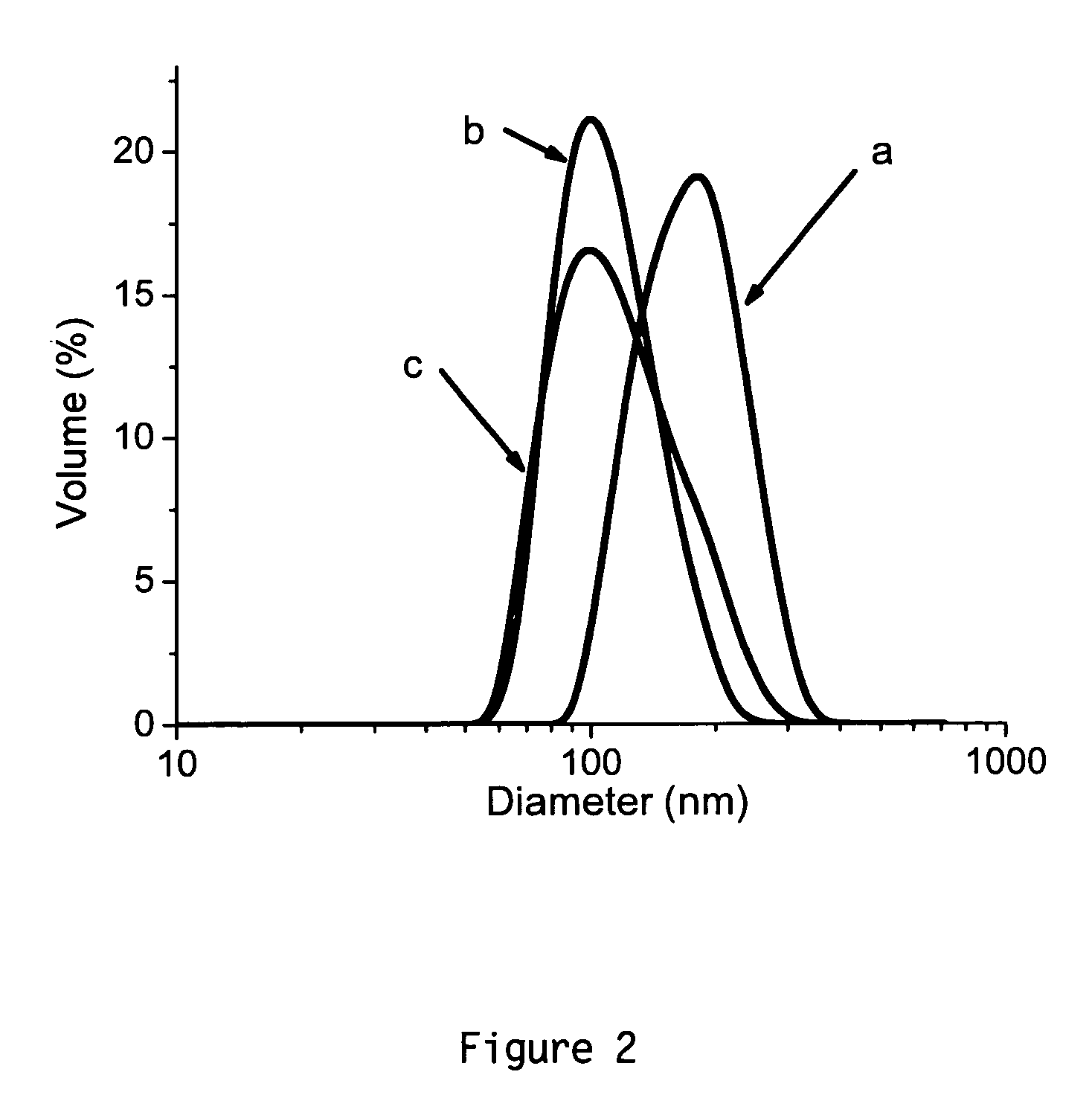Synthesis of Reversible Shell Crosslinked Nanostructures
- Summary
- Abstract
- Description
- Claims
- Application Information
AI Technical Summary
Benefits of technology
Problems solved by technology
Method used
Image
Examples
example 1
Thermally Responsive Vesicles and their Structural “Locking” via Polyelectrolyte Complex Formation
[0036]Here we report the first example of vesicle formation from the self-assembly of hydrophilic-hydrophilic block copolymers directly in water by variation of the solution temperature. The resultant vesicles were then shell crosslinked through polyelectrolyte complexation as shown in Scheme 1.
[0037]General Procedure for the RAFT Polymerization of AMPA CTP (0.0078 g, 0.028 mmol) and AMPA (1.00 g, 5.6 mmol) were added along with DI water (2.0 mL) to an ampoule. V-501 (0.00156 g, 0.0056 mmol) dissolved in 1.0 ml dioxane was then added. The solution was stirred until all the CTP was dissolved. The ampoule was sparged with nitrogen for approximately 30 min. and then placed in a preheated oil bath at 70° C. The reaction was terminated after 24 h. by cooling the reaction tube in an ice bath followed by exposure of the catalysts to air. The product was purified by dialysis against water (pH 4...
example 2
Responsive Nano-Assemblies via Interpolyelectrolyte Complexation of Amphiphilic Diblock Copolymer Micelles
[0048]In this example we report a facile method for the synthesis of reversible shell “locked” nano-assemblies with solution behavior idealized in Scheme 2.
[0049]Block copolymers of N,N,-dimethyl acrylamide (DMA), N-acryloyl alanine (AAL) and N-isopropyl acrylamide (NIPAM) prepared via sequential aqueous RAFT polymerization are show to undergo a reversible, temperature-induced unimer-to-micelle transition. Alternatively, block copolymers of N,N,-dimethyl acrylamide (DMA), N-acryloyl valine (AVAL) and N-isopropyl acrylamide (NIPAM) can be used to advantage. Above the phase transition temperature, the resulting micelles are cross-linked via interpolyelectrolyte complexation of the poly(AAL) segments in the hydrated shell with the cationic homopolymer poly[(ar-vinyl benzyl) ammonium chloride] (PVBTAC). These interpolyelectrolyte complexed micelles remain intact upon cooling below t...
example 3
Synthesis of Reversible Shell Cross-Linked Micelles for Controlled Release of Bioactive Agents
[0087]The key features of micelle assembly, reversible cross-linking and thermo-responsive behavior are illustrated in Scheme 7.
[0088]PEO-b-(DMA-s-NAS) Copolymers. Having established a suitable polymerization procedure for the homopolymerization of DMA from the PEO macro-CTA, we then examined the incorporation of an active monomer by the statistical copolymerization of DMA with NAS. NAS was chosen as the active monomer due to its enhanced activity toward primary amines and relatively lower susceptibility to hydrolysis.52 The copolymerization of NAS with other vinyl monomers via RAFT has already been reported52,53 although the homopolymerization of NAS by RAFT is uncontrolled.54 Such polymer precursors have been used as supports for oligonucleotide synthesis, to elaborate polymer-oligonucleotide conjugates, or used as active sites in the synthesis of comblike polymers.56 Our results for the ...
PUM
| Property | Measurement | Unit |
|---|---|---|
| Temperature | aaaaa | aaaaa |
| Critical solution temperature | aaaaa | aaaaa |
| Responsivity | aaaaa | aaaaa |
Abstract
Description
Claims
Application Information
 Login to View More
Login to View More - Generate Ideas
- Intellectual Property
- Life Sciences
- Materials
- Tech Scout
- Unparalleled Data Quality
- Higher Quality Content
- 60% Fewer Hallucinations
Browse by: Latest US Patents, China's latest patents, Technical Efficacy Thesaurus, Application Domain, Technology Topic, Popular Technical Reports.
© 2025 PatSnap. All rights reserved.Legal|Privacy policy|Modern Slavery Act Transparency Statement|Sitemap|About US| Contact US: help@patsnap.com



